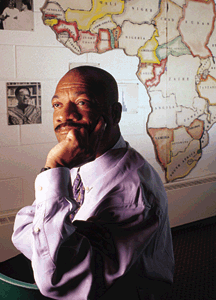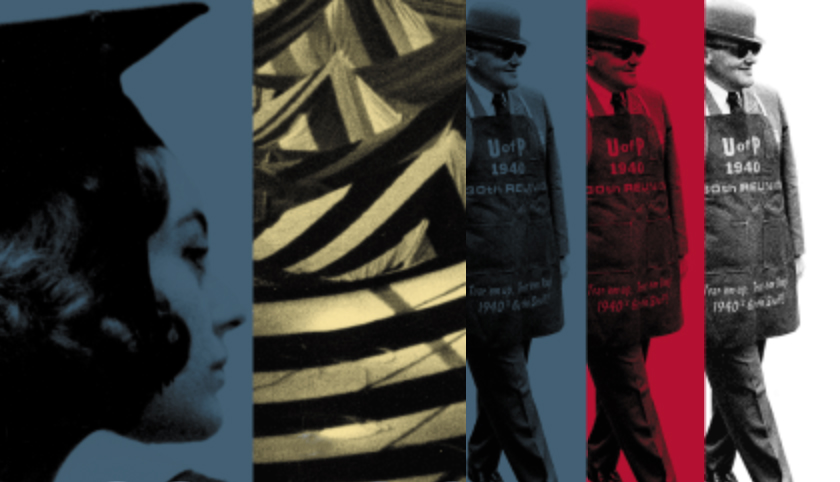
For a century the Gazette has been reporting on the annual rite of spring —Alumni Weekend and Commencement —in which alumni renew their ties with Penn and each other and the latest set of graduates says goodbye to their student days.
“The greatest class had their greatest reunion, now you can close up the University.”
So concluded Samuel Horton Brown M’1899, reporting in the June 28, 1929 issue of the Gazette on the 30th Reunion of his Medical School class. Needless to say, his advice was unheeded. The University went right on producing new crops of graduates, and those graduates kept coming back for reunions, through the Depression that would hit later that year, the Second World War, the turmoil of the 1960s, and up to the present—just as they had back when Dr. Brown himself was a freshly minted graduate at the turning of the last century. The Gazette wasn’t around to record the festivities in 1899, but ever since its founding in 1902 the magazine has provided annual coverage of alumni reunions and commencement ceremonies. This year’s versions appear on page 38 and page 14, respectively. Here are some words and pictures through the decades.
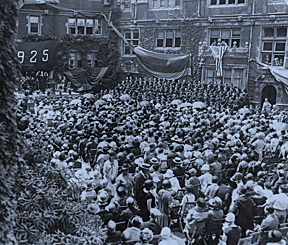
A Night of Folly
Alumni Day ended with a celebration in the Triangle that surpassed all previous events in the abandon of its enjoyments. Doctors forgot their patients, lawyers their cases, and dignified brokers and business men threw aside restraint and returned both in spirit and action to college days. They will work better for the memory of it. It was a night of folly in which fireworks, fun, and foolishness ran riot; ’99 had coarse straw sun hats and beards from the agricultural district; ’02 Law wore barrels on their bodies, signifying the manuscripts they have issued, and the number of fees they have acquired; ’75 in pajamas; ’01 with tin dish pans, and one old class of the civil war time disported around the bonfire in shirt sleeves. The absence of the usual supper was compensated for by a surplus of refreshments of a varied and composite description, dispensed with lavish hospitality by the classes, from their rooms in the dormitories. The good of former alumni nights was perpetuated; the bad largely left out.—“Alumni Night,” June 13, 1903
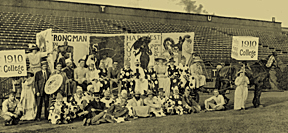
The Morning After
By order of the Dormitory Parietal Committee and the University Trustees, alcoholic liquors, of all kinds, are barred from the dormitories on Alumni night.—“Alumni Day Announcement to Classmen,” June 12, 1909
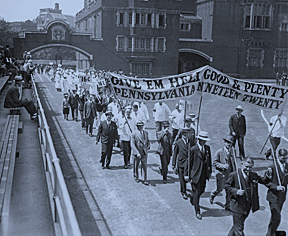
A Long Black Line Appears
The weather man is always in a genial mood on Class Day. He knows that Class Day is, after all, the high point of Commencement Week. There is a draped barricade cutting off the upper end of the Triangle. In front of the arches dividing the Triangle from the Little Quad a platform has been erected, draped with the Red and Blue and with flags, banked with flowers, with gladioli that are not quite red enough and larkspur that are not quite blue enough, but that make a beautiful bit of color and perfume.Outside, the Seniors in cap and gown hurry to the meeting place. The pointed green cupolas of the Tower look down on the fathers, the mothers, the sweethearts, and the sisters who form the audience.A long black line appears at the farther end. It winds over the grass, led by the Senior President and the new President who will take his place. The boys fill the side benches. A little mother, with nearsighted glasses, on the front row, points out her boy among the black-coated figures.The President salutes the Class—the historic and unusual class that four years ago entered, as do all Freshmen, with no appreciation of the solemn responsibilities that would fall upon it—in a speech full of ideals, of loyalty to Pennsylvania, and of fraternal love. The audience rises and sings with the Class the greeting to all loyal classmen to pay homage to the Red and Blue. The boys wave their mortar-boards, “Hurrah, Hurrah, Pennsylvania.”—“Class Day and Commencement,” by Beulah B. Amram, June 27, 1919
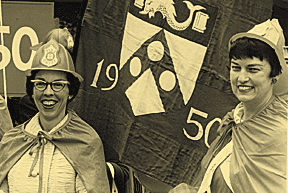
The Marx Brothers at Penn
One of the humorous happenings—and they came along every minute—was the choosing of the rooms at our hotel where we stayed overnight. Men picked rooms carefully, leaving the door open, a suitcase on the bed to show occupancy. The latecomers, finding the best rooms taken up, calmly placed their own suitcases on the bed and the other suitcases under the bed. This denoted occupancy and also prevented the first occupants from even finding their suitcases. While these men chuckled over their strategy and sat up late, others crept to bed, threw both suitcases out of the choice rooms into the hall and locked the door and went to sleep.—“63 Men Back for ’99 C,” June 27, 1919
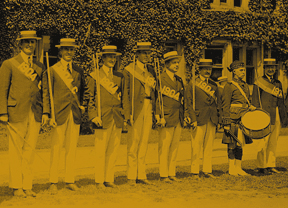
Commencement Comes to Campus
This year’s Commencement will be held on the campus instead of in the Metropolitan Opera House. This will be the first time in the history of the University that Commencement exercises will be held on the campus. The feature of the new form of Commencement will be the academic procession. It is planned to have the graduating classes assemble in their various departmental buildings and then join the procession, headed by the faculty, the Board of Trustees and other officers. The procession will then proceed through the campus to Weightman Hall. It is felt that the new form of Commencement will be much more acceptable and give a truly university atmosphere to it.—April 28, 1922
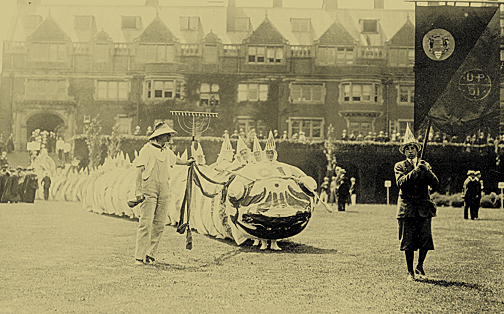
One Beloved Spot
All that is new and interesting finds its way quickly into the colleges. All that is old and valuable is preserved there. There is no figure, however, comprehensive enough to symbolize the multiplicity of functions of a college. Cloister, wireless station, exchange, laboratory, watchtower raised toward the stars—college is all of these and a thousand things else. “Cosmopolitanly planned,” college prepares men to judge the value of things in life, and begins their training for those professions that direct the most important work of the world.
God gave all men earth to love,
But since our hearts are small,
Ordained for each one spot should prove
Beloved over all.
That “one spot … beloved over all” is Pennsylvania, our college. But let not our hearts be so small as to allow only “our” college. Pennsylvania belongs, too, surely, to our country and to the world.—Commencement address by Dr. Cornelius Weygandt, June 30, 1922
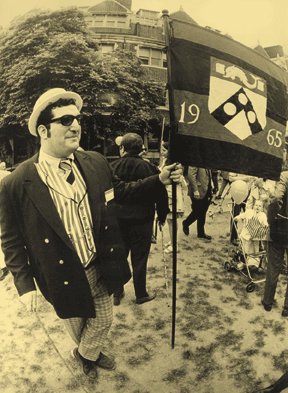
Mummy’s the Word
Saturday noon saw us assembled at 3641 Locust Street. Dressed in white shirts and trousers, with red and blue turbans, and headed by our own band, we joined the other classes in the quadrangle and paraded to Franklin Field. The whole class seemed to be full of spirits and many other things.
One of the features of the parade was the mummy carried by 1918. Arriving at the Stadium, the mummy was cut open, freeing many red and blue balloons with ’18 on them, and last, but not least, disclosing to view our outgoing and incoming presidents, Vic Chiquoine and Bud Bertolet.—“1918’s First Five-Year Reunion,” June 29, 1923
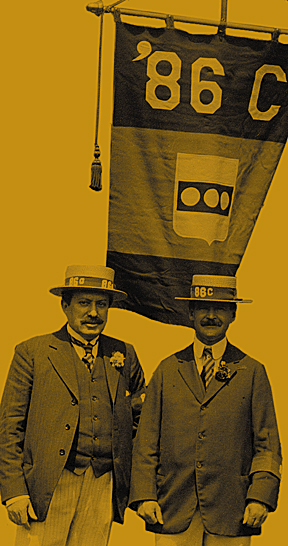
A New Mark in Laugh Creation
An enthusiastic, colorful, and spirited Alumni Day! As never before the homecoming of Pennsylvania’s sons this year showed in unmistakeable signs the increasing interest in and loyalty to the institution founded by Benjamin Franklin.
Never before has there been an Alumni Day parade of such magnitude and variety, and providing as many thrills and laughs for the ten thousand relatives and friends that filled the south stands to cheer the returning graduates.
The Class of 1875, fifty years out, with over twenty-five men in line, gained the laurels for the older classes, while 1910, dressed as farmers and led by a huge hayrick drawn by a pair of dapple gray horses, provided much merriment, particularly when the hayrick proceeded to thunder around the track at a full gallop during the ball game.
To the Class of 1915, however, went the honors of the day. With over two hundred men dressed in stunning black and white Pierrot outfits and supplemented by an ice wagon, brake cart, balky horses, hula dancers, fake animals, and many other laugh creators, 1915 set a new mark in their efforts to make the parade a success.—“Record Turnout for Alumni Day,” by Weaver L. Marston ’18, July 3, 1925
Depression by Damned
In spite of the dad-burned depression, we had a good crowd out and they are all of the kind who can be depended upon to bring others out to our next séance.—George A. Cunney, on the Class of 1917’s “Big Fifteenth Reunion Party,” June 1, 1932
Presidential Prank
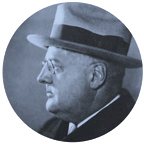
An amusing incident directly following the Alumni Day parade on Franklin Field was staged by the Class of 1927. One of their number rushed up to the sergeant in charge of the police detail and exclaimed that President Roosevelt had arrived and they had no police escort. The sergeant promptly blew his whistle frantically and cops came running from all directions. Thereupon there entered from the north gate an open automobile bearing an almost exact replica of President Roosevelt in the person of J. Henry Smythe, Jr. ’09 of New York, well equipped by Jacob Reed’s Sons in high hat, morning coat, striped trousers, cane, gloves, etc.
Following the car was the Class of 1927 dressed as Justices of the Supreme Court. One large poster proclaimed that the building of the Supreme Court was a WPA project. President Gates came down from his box to greet the distinguished occupant of the automobile and the whole affair was greeted with much applause.—July 1, 1937
“Pardon me, sir. I’m used to white rabbits in morning clothes, and many other such extraordinary creatures, but pray, sir, what are you? And what brings you here?”
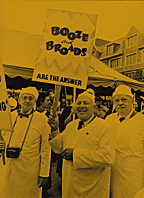
Alice in Reunionland
As she stood at the corner of 37th Street and Woodland Avenue on June 11, Alice’s attention was drawn by a strange little character who scuttled across the intersection against the light, to the accompaniment of violent Irish imprecations from the gendarme on duty.
Safely on the dormitory pavement, the law-breaker stopped to rest, setting down the bulging portmanteau which had depended from his right hand, at the same time mopping his brow with a brilliant red-and-blue handkerchief. Alice was startled to see that he wore a red-and-blue checked vest under his tasteful blue camel’s-hair sport jacket, and that his rakish pork-pie fedora sported a jaunty red-and-blue feather.
She approached him diffidently. “Pardon me, sir. I’m used to white rabbits in morning clothes, and many other such extraordinary creatures, but pray, sir, what are you? And what brings you here?”
The stranger spoke, and in his wheezing voice lurked the gay ghost of once sprightly and youthful tones. “I, my dear, am an Alumnus. I was privileged once to pass happy hours in these surroundings, and I am making my annual pilgrimage to renew the wellsprings of my youth.
“This is the University of Pennsylvania, and I am to sleep in the dormitory room tonight where I first slept as a new student, while tomorrow I will enjoy the Alumni Day program.”
As Alice was about to speak again, the Alumnus suddenly grasped his portmanteau (“It’s full of beverage,” he twinkled) and popped out of sight through the dormitory gate.—“Alice in Reunionland,” by Phil Farcel W’41, September 1948
Flashback Flashcards
We assembled again Saturday noon at the “Class of ’33 Mall” and marched down Spruce Street to Franklin Field with our Chinese dragon costumes, representing “Depression” and “War,” along with an appropriate array of picket signs depicting the history of the class and problems of our times since leaving the University. A few typical mottoes recalled: “Liquor $1.00 a Fifth,” “O.P.A.,” “Bootleg Booze,” “C.C.C.,” “Draft 1A,” “Draft 2A,” “Atom Bomb,” “Orbit,” “Jet Planes,” “T.V. Commercials,” “Price Ceilings,” “Rent Control,” “Red Stamps,” “Green Stamps,” “We Can Take It,” “We Had To,” and “Freedom 7.”—Report on the 30th Reunion of the Class of 1933, July 1963
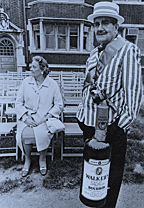
Commencements are Changing, Too
It was no ordinary Commencement, this 214th in the University’s long history. There are always ample opportunities to applaud, but this year there seemed to be more than usual.
For one thing, it was the last Commencement over which Gaylord Harnwell presided as president. He got a standing ovation. And his successor, Martin Meyerson, delivered the Commencement address. He got a rousing reception, and his speech was interrupted several times by applause.
There was a third speaker this year—a member of the Class of 1970. His theme was the need to end the Indochina War and get on with reform in this country. At the end of his speech (which was warmly applauded by many of the graduating class and roundly hissed by many in the audience), he asked for a walkout of the graduating students to demonstrate that this is not a time for business as usual. About 300 did—and were applauded by many of those who stayed. When the walkout was completed, those who stayed were applauded by most of the audience.
What the walkout demonstrated is that, like almost all other things connected with university life, Commencements are changing, too.—“Applause!” July 1970
Commencement Goes Outdoors
The University’s 230th Commencement took place on Franklin Field. Moved outdoors from the heretofore customary assemblage at the Civic Center, the colorful ceremony began under a cloudless, pale blue sky that was gathering woolpacks by the time it ended.
The graduates were a bit far from the stands for the spectators to recognize those they knew, but many wore decorations on their mortarboards: plastic whirligigs, stuffed animals, inflatable palm trees and globes of the world, a deflated soccer ball, a miniature royal crown, a fern, and—probably the wisest choice, given the heat—a solid layer of tin foil.
Although the graduates were supposed to have been temporarily relieved of any champagne bottles at Superblock, a few students managed to smuggle them in. As their degrees were officially conferred, they shook the bottles vigorously, uncorked them, and showered the air with bubbly.—“An Academic Rite of Passage Moves Outdoors,” June 1986
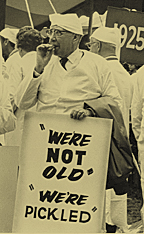
No Silly Hats
When, in one of the newsletters that were sent in the course of the academic year to the Class of 1964, those in charge of attendance for the class’s 25th Reunion urged their constituents to come celebrate, they made a series of promises. Most of them involved the usual sort of thing: good times, nostalgia, camaraderie. Then there was the clincher: “You will not have to wear a silly hat in the parade [of classes] on Saturday!”—“The Class of 1964 Throws One Helluva Party,” June 1989
Some Dissenting Voices
Over the years, not everyone has gotten into the spirit—or spirits—of Alumni Weekend celebrations. Here are two examples:
Disheartening Spectacle
If there is any sight more disheartening than the spectacle of freshman trying to behave like adults, it is the spectacle of adults trying to behave like freshmen.
I am grateful to Alma Mater. Likewise, I owe much to my physical mother, but I have not considered, so far, putting on a bizarre costume and getting tight in her living room as an earnest of that devotion.
F.F. Van de W.
—“Correspondence,” April 1, 1934
Komedy Killer
See the funny man with the great big whiskey bottle dangling from his waist on Alumni Day!
See the funny men and ladies with their funny signs: “We’re pickled,” “We’re Red Hot,” and “Booze and Broads.”
Where is the Generation Gap, Daddy? Is it between the funny men and ladies’ ears?
Please Daddy, promise me that when I’m an Old Grad, I won’t have to go back and be Komikal on Funny Hat and Funny Sign Day.
Albert G. Miller C’27
—“Letters,” October 1970




